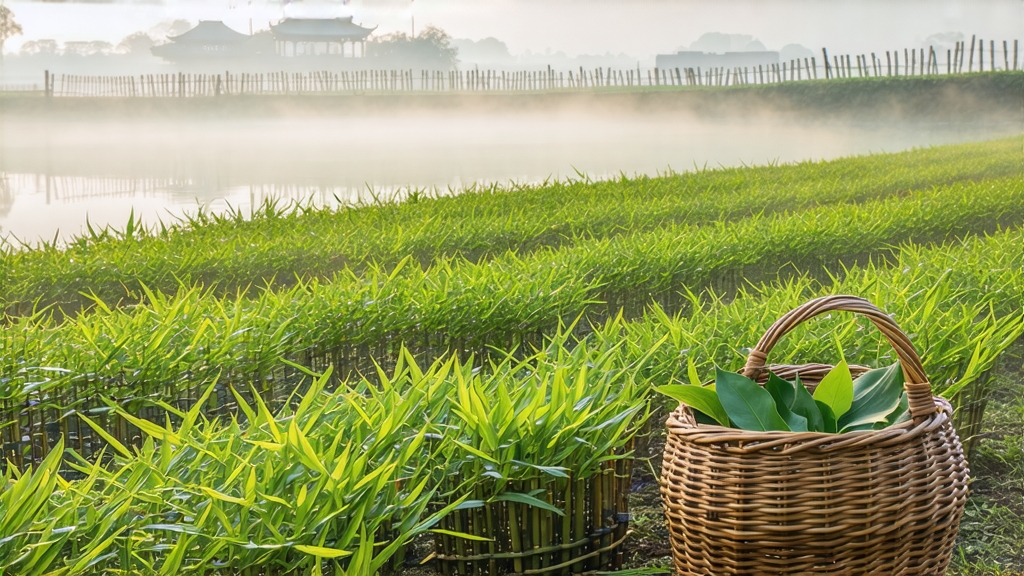
Longjing, literally “Dragon-Well,” is more than a tea; it is a liquid postcard from Hangzhou’s West Lake, a sip that has carried five dynasties of Chinese poetics into the modern cup. First recorded in the Tang Dynasty (618-907) but canonized during the Qing Qianlong Emperor’s 18th-century southern tours, Longjing was reputedly so beloved by the monarch that he planted eighteen imperial bushes still thriving today at Shífēng Peak. Over centuries the name evolved from an obscure hill spring—Dragon-Well—into a protected geographical indication (PGI) covering barely 168 square kilometers of microclimate where sandstone hills, sweet spring water and lake-born mist conspire to slow leaf growth, concentrating amino acids that translate into the famous “four uniques”: jade color, vegetal aroma, chestnut sweetness and sword-shaped leaf.
Within this tiny appellation four traditional crus are recognized by connoisseurs. Shífēng (Lion Peak) yields the most sought-after leaves, picked when the spring night temperature hovers around 10 °C, locking in a creamy lanolin fragrance. Méijiāwǔ, a terraced valley cloaked in peach and plum blossoms, adds floral top notes. Wēngjiāshān offers a slightly stonier minerality, while Hǔpáo (Tiger-Run) claims the sweetest water with which to fire the tea. Beyond these core zones the term “West Lake Longjing” may legally be used, yet the further the leaf travels from the lake’s humidity the more it loses its hallmark “ring of sweetness” that lingers at the back of the throat like a low bell.
The craft begins in the pre-dawn chill of Qingming festival, when buds are still closed “sparrow’s tongue” pairs—one leaf embracing one downy tip. Pickers, mostly women who have climbed the hills for three generations, snap the stem with a fingernail’s click, dropping the sprigs into bamboo baskets lined with gauze to prevent bruising. By 10 a.m. the harvest must reach the village hearth, where 200-gram batches are repeatedly hand-tossed in woks heated to 80 °C, then cooled to 60 °C, then reheated—a ten-minute ballet demanding 270 precise presses, sweeps and shakes. The goal is not mere desiccation but “fixation of green,” arresting oxidation while shaping the leaf into the iconic flat, smooth strip that slides like jade armor against the porcelain wall. Masters judge readiness by ear (a rustling like silkworms), by touch (no moisture at the stem’s heart), and by nose (a shift from grassy to toasted chestnut). Once residual moisture drops to 5 % the tea is spread on bamboo trays for “hui qing,” a six-hour rest that equalizes internal water before a gentle 50 °C finish roasting. The entire process consumes four hours of focused labor for every 500 g of finished tea, explaining why authentic pre-Qingming Shífēng commands over a thousand yuan per 100 g.
To brew Longjing is to negotiate between reverence and restraint. The classic Hangzhou method uses a tulip-shaped glass tumbler of 200 ml, allowing the foreign eye to watch leaves dance vertically—what poets call “the green rain.” Three grams suffice; water at 80 °C is poured first to one-third height, awakening the buds with a soft swirl, then topped to seven-tenths after thirty seconds. No lid is used, lest trapped steam stew the aromatics. First infusion lasts one minute, second forty seconds, third one minute twenty, each unveiling a different stratum: initial fresh soybean milk, mid-palate roasted cashew, finish drifting into white-fleshed peach. A fourth brew, if the leaf was premium, gifts a whisper of sweet mineral that mirrors the limestone aquifers of its birthplace.
Professional cupping follows a quieter choreography. Five grams are placed in a 110 ml white porcelain gaiwan; water precisely 85 °C is poured and decanted after twenty seconds while the taster inhales the gaiwan lid’s underside, hunting for three aromatic peaks: front “qing xiang” (green bamboo), mid “dou xiang” (toasted legume), back “hua xiang” (orchid-like). The liquor should glow like early-spring willow catkins, never brassy. Slurped across the palate, it must coat the tongue evenly, leaving the